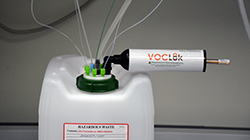Best Practices for Changing VOCLok Filters
The VOCLok is a great tool, but it needs filter replacements to operate properly. Executing the replacement process is more an art than a science—but luckily, there are best practices to help guide you to do this efficiently and economically.
High-performance liquid chromatography (HPLC) machines are crucial for analytical labs everywhere. When they process some solids and liquids, they emit volatile organic compounds (VOCs). These require a waste collection system to prevent toxic solvent exposure. Unfortunately, many solvent waste container systems in pharmaceutical, healthcare, and higher education research don’t adequately address the safe and compliant collection of hazardous waste.
Outstanding VOC Solution
One of the best solutions to containing these VOCs is Triumvirate Environmental’s VOCLok solvent waste container system. It was designed by industry experts to improve safety and compliance in the lab areas—while bringing a clean and consistent look to the management of these waste units.
VOCLok also enables lab compliance with Resource Conservation and Recovery Act (RCRA) regulations. These require containers, when not being filled, to remain closed. So, the collection of hazardous waste from HPLC machines poses unique challenges to compliance and lab professionals. The waste collection systems were not designed to comply with RCRA container closure requirements. And, because these machines are used frequently, it is almost impossible to cap or close these containers the moment they are not generating waste.
While the VOCLok has minimal maintenance and lower overall cost than many alternatives, it still requires regular filter upkeep. The VOCLok system effectively captures VOCs, and the filter lifecycle directly correlates to the volume and type of solvents being captured. Because these variables often vary from one machine to another—and sometimes the usage of a single machine may also vary—prescribing a filter change-out schedule without use data is very tough.
VOCLok Filter Best Practices
Managers naturally will ask about the most cost-effective way to swap out the filters—without sacrificing safety and performance. Of course, all lab environments are going to be (even slightly) different—operating in unique circumstances and for varied objectives. So, while it’s difficult to create a blanket change-out policy, we have some general advice. For successful, efficient, and reliable filter maintenance, we recommend you consider the following:
Installing breakthrough indicators: The top of the VOCLok filter can attach to a breakthrough indicator—a device that measures the flow of the VOCs passing through the filter. When the filter can no longer capture VOCs, the breakthrough indicator changes colors. So, the breakthrough indicator is a reliable and precise instrument to measure the effective lifecycle of any filter.
If there is a drawback to this method, however, it’s that these devices can be costly. So, to reduce the expense of the breakthrough indicators—without sacrificing accurate usage measurement—we recommend distributing the indicators among 10% of the filters. (Of course, this approach applies when most of the machines are similar.) Closely observe the indicators—even perhaps create a regular check up with logs to record status. When the indicators turn color, it’s reasonable to assume the time to swap out all the facility’s filters has come.
Implementing a routine schedule: Recording performance data and benchmarking can drive successful filter maintenance programs. Over time, by closely observing VOCLok filter performance, managers can create reasonable predictions about when to swap out the systems. Managers can gather the initial performance data by leveraging VOCLok breakthrough indicators, as discussed above. Over a set amount of time, managers can reasonably estimate how much VOCs the HPLC machines at your facility generate—and when the filters need replacing.
Adherence to manufacturer recommendation: If managers prefer not to make their own filter activity measurements, then they can simply adhere to the manufacturer’s own recommendations—and change the filters every quarter. From a planning and logistics perspective, this provides an easily repeated scheduling protocol. While it makes sense to plan conservatively, I’ve observed filters function adequately past the three-month deadline.
On the other hand, I’ve also seen filters go past three months of useful life. And I’ve also encountered high-throughput machines that exhausted their filters’ capacities in under three months. But, at the very least, if they do not have the capacity to collect more specific use data, managers should consider the quarterly deadline when they plan their change-out schedules.
VOCLok Solutions for You
Need to talk about VOCs? Triumvirate Environmental specializes in supporting solvent waste container systems used in pharmaceutical, healthcare, and higher education research. With the correct equipment and processes, you can avoid RCRA violations and citations.
If you want to save time, money, and eliminate compliance worries now—talk to us today.







